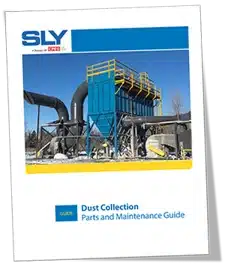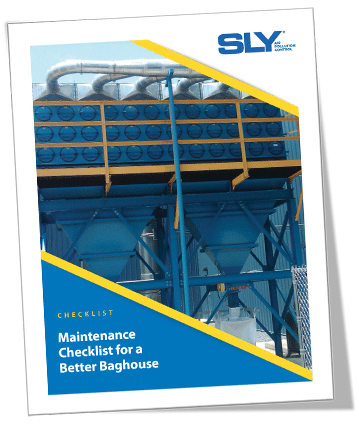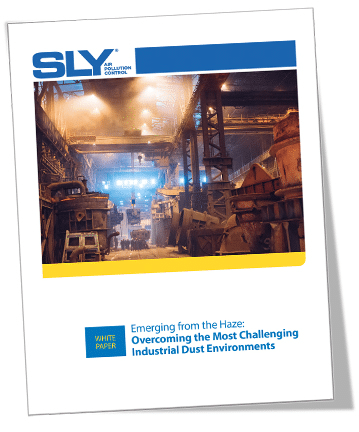The information provided on this website is intended as a guide for filter bag applications. SLY, LLC. makes no guarantee about the performance or results you can expect from the application of this information unless provided in writing by our staff.
Why Choose Polyester Felt?
Polyester Temperature Range
Polyester Felt (PE) The most commonly used and cost-effective filter felt in modern pulse jet style baghouses. Typical applications range from cement plants to electric furnaces. It has a normal maximum continuous operating temperature is 275°F. Polyester filters offer very good resistance to chemicals, abrasion, and dry heat degradation. This filter is good for dry heat applications and superior to other synthetics with the exception of Nomex® (Aramid) and Teflon® in this regard. Polyester is not a good choice for moist heat and subject to hydrolytic degradation under certain circumstances. Polyester offers good resistance to most mineral and organic acids except high concentration of nitric, sulfuric, and carbolic acids. It has good resistance to weak alkalis and moderate resistance to strong alkalis at low temperatures. Not recommended for high concentration of strong alkalis at high temperatures. Polyester also has good resistance to most oxidizing agents and excellent for most organic solvents. It is not recommended for some phenolic compounds.
Fiber Filter Properties (PDF)
Fiber Filter Chemical Compatibility Chart (PDF)
- Available Finishes for Polyester: Plain (PL); Singed (SI); Glazed (GL); ST-01 (Oleophobic); ST-04 (Code 9); PTFE membrane (XP); ST-08 (double dip ST-01); ST-09 ; ST-10; ST-11; Fire Retardant (FR); SlyCharge (EX); ST-12 (SS fibers); Epitropic (EP); SlyHE (High efficiency). See detail information on finishes here.
- Available Weights for Polyester: 16 oz./yd2, 18 oz./yd2
Polyester Felt Popular Finishes:
Singed Polyester (SIPE) – The felt is singed on the dust cake side for improved cake release. The most common type of filter media used in modern baghouses. The process involves exposing the surface fibers to an open flame that melts back the loose fiber ends to which dust particles could adhere.
Glazed Polyester (GLPE) – This process involves running the felt through two heated rollers to melt back the loose fiber ends improving the cake release. The process can also compress the felt to smooth the surface, further improving the dust cake release.
SlyTech-01 (ST-01) – Oleophobic -water and oil repellent finish. SlyTech-01 is a complete PTFE bath that provides an excellent cake release finish to each fiber. This finish is cheaper and more durable than a membrane that can be easily scratched. Click here for more information on ST-01.
Specialty Polyester Felts:
Duo-Density Polyester (SlyMax) – To different size deniers, a finer denier on the surface or collection side and larger-sized fibers on the inside. In a true duo-density felt, the two different sized deniers are separated by a scrim in the middle that provides support and improves filtration. This felt offers better collection efficiency than single denier polyester felts.
- Available Finishes for Duo-Density Polyester: Singed (SI): See detailed information on finishes here.
- Available Weights for Duo-Density Polyester: 16 oz./yd2, 18 oz./yd2
- Click here for more information
SlyHE Sly High-Efficiency Felt (micro pore sized fibers) designed for fine pollutants. Microfibers are a great solution to fine, uniform, free-flowing dust and fine solids in liquid process slurries. Because fiber surface area and separation efficiency are directly related, SlyHE concept felts
- Available Finishes for SlyHE Polyester: Plain (PL); Singed (SI); Glazed (GL); ST-01 (Oleophobic); ST-04 (Code 9); PTFE membrane (XP); ST-08 (double dip ST-01); ST-09 ; ST-10; ST-11; Fire Retardant (FR); SlyCharge (EX); ST-12 (SS fibers); Epitropic (EP); SlyHE (High efficiency). See detail information on finishes here.
- Available Weights for SlyHE Polyester:
16 oz./yd2, 18 oz./yd2 - Click here for more information
- SlyHE Media Spec sheet



 Once you have a dust collector, you need to perform regular inspections and maintenance on your equipment to keep it running properly. That means being proactive with your maintenance and changing out parts before they go bad. Only then can you ensure the safety of your workers and the success of your business.
Once you have a dust collector, you need to perform regular inspections and maintenance on your equipment to keep it running properly. That means being proactive with your maintenance and changing out parts before they go bad. Only then can you ensure the safety of your workers and the success of your business. For improved performance and reliability of your dust collection equipment, Sly recommends a schedule of routine inspections and the timely repair of damaged or malfunctioning equipment. This convenient checklist covers all styles of dust collectors and aspects of baghouse maintenance including pressure drop, emissions, exhaust, ductwork and more.
For improved performance and reliability of your dust collection equipment, Sly recommends a schedule of routine inspections and the timely repair of damaged or malfunctioning equipment. This convenient checklist covers all styles of dust collectors and aspects of baghouse maintenance including pressure drop, emissions, exhaust, ductwork and more. In this white paper, you'll learn why being flexible is the great solution for dust collection: The Importance of Dust Control, The Confluence of Kst and Pmax for Combustibility, Conducting a Dust Hazard Analysis, Case Study on a Customized Solution.
In this white paper, you'll learn why being flexible is the great solution for dust collection: The Importance of Dust Control, The Confluence of Kst and Pmax for Combustibility, Conducting a Dust Hazard Analysis, Case Study on a Customized Solution.